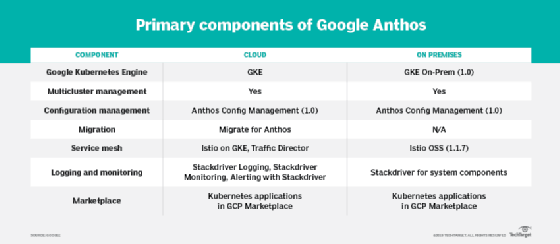
carloscastilla - Fotolia
What you need to know about Google Cloud Anthos
It's time to learn the foundational concepts of Google Anthos, as well as its seven core components that set it apart from AWS Outposts and Azure Stack.
Not all enterprises want to abandon their existing infrastructure or are comfortable running all of their applications on shared services. To address these concerns, top public cloud providers have hybrid offerings that extend their services on premises.
A key challenge for providers is adapting cloud services to host legacy systems that were designed when each application had its own server. Typically, this has been addressed through virtualization, but the strategy of treating the cloud as a big VM server farm sacrifices benefits of a cloud infrastructure, like efficiency, scalability and adaptability.
Google Cloud Anthos does not force organizations to make an all-or-nothing decision on shared services. Instead, it gives customers the option to use cloud technology -- namely, containers and Kubernetes clusters -- on existing internal hardware. With a consistent design and set of services for both on-premises and in-cloud deployments, Anthos gives organizations the freedom to choose where to deploy particular applications and migrate workloads between environments.
Google Cloud Anthos enables enterprises to use container clusters, instead of cloud VMs, to bridge the gap between legacy software and cloud hardware.
Anthos 101
Google Cloud Anthos, previously known as Google Cloud Services Platform, is a cloud-agnostic container environment. It uses Kubernetes for workload orchestration and Istio for app and microservices traffic management, as well as routing.
Anthos is purely a software product that can run on existing hardware. Google has partnered with hardware providers, such as Cisco, Dell EMC, Hewlett Packard Enterprise, NetApp and Robin.io, to deliver prepackaged Anthos systems, including on hyper-converged appliances. However, it can run on any servers capable of hosting Kubernetes clusters.
Anthos aims to solve the problem of containerizing legacy applications by including migration software that transforms VM images into containers before deploying them onto Anthos. Lastly, the service is rounded out by a host of monitoring, security, authorization and application management tools.
Core components, features and pricing
The foundation of Anthos is a container cluster managed by Google Kubernetes Engine (GKE). To accommodate hybrid environments, Anthos supports both the GKE managed container service and a GKE On-Prem environment that bundles the same set of management and security features.
Atop the Kubernetes base, Anthos adds the following core components:

Take a closer look at the seven main components of Google Cloud Anthos.
- Anthos Config Management: This component provides the tools required to set up and administer multiple Kubernetes clusters, while maintaining a consistent set of network and security policies across environments. It manages clusters via configurations that are stored in repositories such as GitHub or Google Cloud Source Repositories.
- Istio on GKE: This service mesh securely connects clients to containerized services and applications while managing traffic flows between microservices. It also enforces security and usage policies.
- Traffic Director: This traffic control plane for service meshes adds multi-region load balancing, health checking, demand-based autoscaling and more. It uses standard APIs that enable it to work with sidecar proxies, like Envoy.
- Stackdriver: Google Cloud Platform's (GCP) monitoring, management and debugging service provides a central repository for network, application and infrastructure telemetry. Google offers two support options: Legacy Stackdriver and Stackdriver Kubernetes Engine Monitoring.
- Migrate for Anthos: This tool automates the process of migrating legacy virtualized workloads to GKE containers. It can also convert workloads from VMware vSphere, Amazon EC2 and Microsoft Azure VMs.
- Cloud Run: This serverless platform can run event-driven workloads and deploy containers to a GKE cluster. It enables apps to invoke container-run functions without configuring servers, and it also automatically sizes compute resources according to workload demands.
- GCP Marketplace: Anthos users can access prebuilt Kubernetes applications and development stacks on GCP Marketplace and automate container development processes using CodeBuild.
Additionally, Apigee -- GCP's API management service -- simplifies the process of exposing programming interfaces for services running on GKE.
Usage
Google uses containers to deliver a consistent hybrid cloud environment, and enterprises can use Google Cloud Anthos' various components to manage and coordinate their on-prem and cloud workloads. However, we still don't know how the service works in practice since it's so new and there aren't independent case studies from enterprises using it in production.
Google has a lot experience with containers, including initially developing Kubernetes. If SAP HANA can run on a Kubernetes cluster, an enterprise app that can be virtualized should work with Anthos.
Organizations aggressively pursuing cloud-native applications with containers and microservices will find a lot to like with Anthos since it is built atop a strong container-as-a-service platform and provides a smooth migration path for legacy applications.
Competition
Google's hybrid strategy is decidedly different than that of AWS or Microsoft, which continue to use virtualization to maintain consistency between environments rather than containers.
For example, AWS partnered with VMware to provide an enterprise virtualization platform on AWS infrastructure. Organizations that have standardized on VMware and want to preserve that investment as long as possible will find VMware Cloud on AWS the best fit. AWS also has Outposts, which packages infrastructure and services inside private data centers and operates like Amazon's public cloud.
Similar to Outposts, Microsoft has developed a subset of Azure capable of running on premises via Azure Stack. Microsoft shops will likely find Azure and Azure Stack the most natural path to hybrid.








